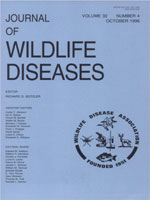In August 1992, six mule deer (Odocoileus hemionus hemionus) fawns and four elk (Cervus elaphus) calves (n = 2) or yearlings (n = 2) each were inoculated orally with 50, 250, or 2,000 metacercariae of the liver fluke Fascioloides magna to evaluate their potential to serve as definitive hosts. Animals were maintained for up to 403 days. Three mule deer each inoculated with 50 metacercariae survived the infection and shed eggs in feces; thus mule deer can function as definitive hosts for F. magna. The other three mule deer inoculated with 50 (n = 1) or 250 (n = 2) metacercariae died from fluke infection on days 91, 150, and 162 days postinoculation, respectively, and only immature F. magna were recovered. One elk calf inoculated with 2,000 metacercariae died from fluke infection 44 days after inoculation. The remaining three elk, each inoculated with 250 metacercariae, survived infection, and two of the three shed eggs in feces. The third elk contained only one immature F. magna at necropsy. The prepatent period in mule deer and elk was approximately 6 to 7 months.
How to translate text using browser tools
1 October 1996
MULE DEER (ODOCOILEUS HEMIONUS) AND ELK (CERVUS ELAPHUS) AS EXPERIMENTAL DEFINITIVE HOSTS FOR FASCIOLOIDES MAGNA
William J. Foreyt

Journal of Wildlife Diseases
Vol. 32 • No. 4
October 1996
Vol. 32 • No. 4
October 1996
Cervus elaphus
elk
experimental infection
Fascioloides magna
Liver fluke
mule deer
Odocoileus hemionus




